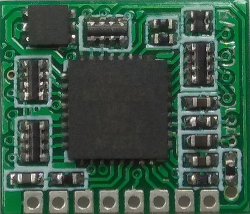Cardecoder V5
|
  |
|
The OpenCar-System Cardecoder V5 is a small, digital decoder for controlling cars on the model
railway. The Cardecoder V5 can receive BiDiB and DCC control signals of a model railroad digital control in
different ways and switch functions in a car like this.
It is compatible with its predecessor the Cardecoder V3 and
expands its hardware with new functions. Highlights of new device are the integrated motor load
control, three additional light outputs and lower energy consumption.
The Cardecoder V5 also uses the familiar RFM7x radio module for communication with the model train
controller. It has a cheaper circuit board design which makes the connection to the wireless
module safer and easier.
It is available as an SMD populated module in the Fichtelbahn
Shop.
|
|
Power supply:
The vehicle decoder are usually powered by batteries. The Cardecoder V5 has an internal voltage
converter, which generates a constant decoder supply voltage of 3.3V. This also allows the
operation of white and blue LEDs on 2.4V batteries. The Cardecoder works with an input voltage
between 2 and 5V. The maximum available output current for vehicle lighting is 100mA.
|
|
Engine:
The vehicle engine is connected to the "Engine +" and "Engine-" connections. On the Cardecoder V3,
external components were needed, these are all included on the decoder board of the Cardecoder V5.
The motor at the Cardecoder V5 is load controlled with high speed PWM. The decoder is designed for
3-5V DC motors with a maximum current consumption of 500mA.
|
|
LED light outputs:
The Cardecoder V5 itself has a maximum of 14 LED outputs, which can be switched via the functions
F0 to F12. Excluded F3 and F4 because they occupy special functions. Eight other outputs (light 10
to 17) are available on the optional decoder extension.
The LED outputs have on-board resistors, which are designed for white, blue, red, orange or yellow
LEDs depending on the application of the output. It is not possible to dim the LEDs as this
significantly affects the optical distance control between the vehicles.
The light effects of the outputs light_1 to light_17 can be freely programmed with effects via CV
(see CV descriptions). Each output can be assigned any one function between F0 and F12 (with the
exception of F3 and F4). The LED light outputs are protected against short circuits. Unnecessary
connections for the optional decoder extension or stop section can be used on the Cardecoder V5 as
LED light outputs.
|
|
IR Distance control:
The Cardecoder V5 transmits information about the distance control via IR diodes in the rear of
the vehicle. This information can be received by the feedback
decoder or a following vehicle. They are used for feedback purposes or for distance control
(in german ASR) between the vehicles. These IR signals are transmitted in DCC format with two
different IR radiation intensities at the rear of the vehicle. The distance control in the
following vehicle detects the signals in two different distances. This makes it possible to drive
closer to a stationary vehicle than to a moving one. The distance control is compatible with
Cardecoder V2 and V3 with current firmware.
|
|
Trailer:
It is possible to operate a trailer with its own decoder on the vehicle. This requires a trailer
decoder (Cardecoder V3 with firmware "trailer decoder").
|
|
Lanes:
The Cardecoder can handle up to 8 different lanes. This allows operation of multi-lane roads, or
intersections with different lanes. The different lanes can be activated / assigned with the
functions F18-24. In this case means F18 → lane 2 to F24 → lane 8.
|
|
Firmware:
The firmware for Cardecoder and trailer is like the entire project under the GPL and can be downloaded in the download
area for free. The firmware of the Cardecoder V5 is protocol compatible with the Cardecoder
V2, V3 and V4. Thus, all these cardecoder can be used together in one system.
|
|
Support:
If you have problems, questions and wishes concerning the software and hardware of the project,
please contact our support forum or the WIKI.
|


